While today’s game has certainly come a long way, there’s nothing particularly modern about soccer itself. In fact, the origins of this sport can be traced back thousands of years, with there being evidence of ball kicking in numerous ancient civilisations.
The version of the sport that we know love today saw its rules come into place in England during the 19th century, but the idea of actually kicking a ball has been around for centuries.
To understand who invented soccer, we need to look at the early forms of the game and to see how they influenced what is now a global phenomenon.
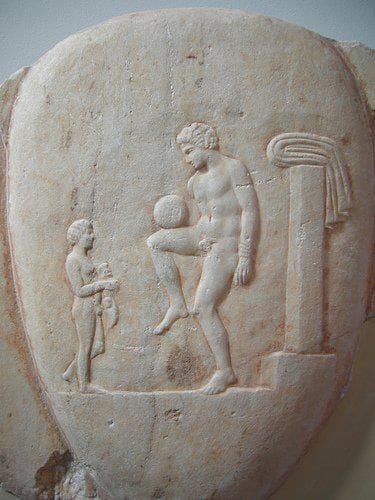
Ancient Greek football player balancing the ball. Part of a marble grave stele, found in Piraeus, 400-375 BC.
The Ancient Roots of Soccer-Type Games
If you want to find the earliest form of a game that looks anything like soccer, you need to look at ancient China. Here, they had a game that was known as ‘Cuju’. The word itself literally means ‘kick ball’. When Cuju was played, the Chinese used a leather ball that was stuffed with feathers and hair.
The aim was for players to kick the ball through a small opening into a net. The game was recognised for the need to use skillful footwork and it was often played in the presence of the royal court. There is also evidence to suggest that the Chinese military also used the game as a form of physical training.
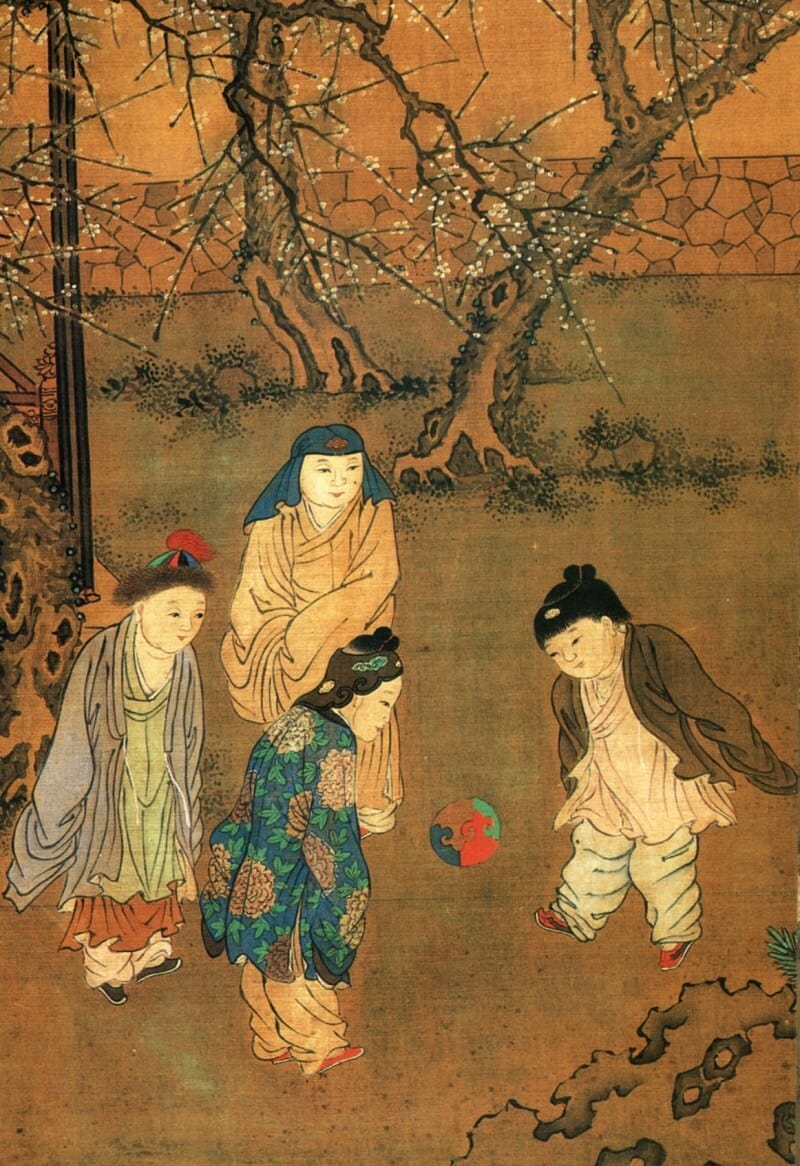
12th century AD, Song Dynasty, image via Su Hanchen
There were also other ancient civilisations in Mesoamerica who were playing ball-based games. The likes of the Maya and Aztecs played a game that was known as ‘Olamaliztli’. This game had its own set of rules and it often saw players needing to use their hips rather than just their feet. Then, there were the ancient Greeks. They had a game that was called ‘Episkyros’ while in Rome, a game called ‘Harpastum’ was played. Though the rules varied widely, the games usually involved teams playing who looked to use a ball to score goals.
During the 7th century in Japan, a game called ‘Kemari’ emerged. This seemed to be more ceremonial rather than combative. Those playing would pass the ball around in a circle, with the aim of keeping it off the ground. Rather than having a focus on scoring, this was all about grace and skill.
When looking at Native American tribes, we can also see that various ball games existed. The Choctaw people were known to play a game called ‘stickball’. This used a small ball with curved sticks. The game was different to modern soccer which has a no hands approach but it still highlights that ball sports have been hugely popular for centuries.
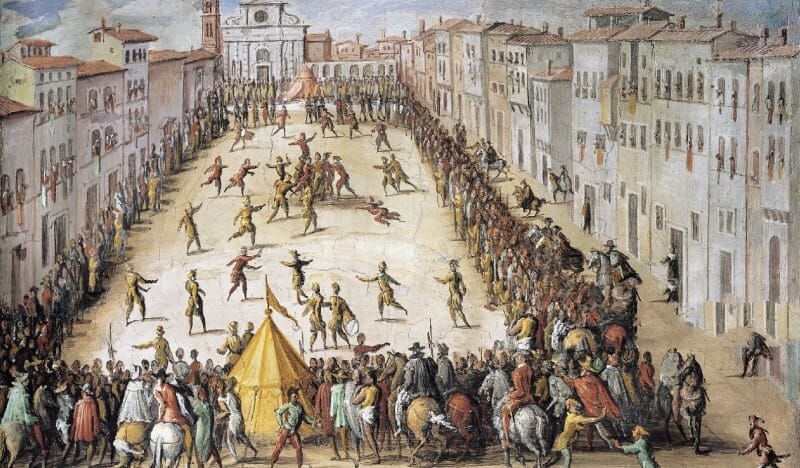
Calcio match in Piazza Santa Maria Novella, in Florence, Italy. Painting by Jan Van der Straet.
Medieval Folk Football in Europe
It was in Medieval Europe that a more recognisable form of modern soccer began to form. It was known as ‘folk football’. This sport had games that were chaotic and completely unregulated. They were played between neighbouring villages and there was no limit to the number of people who could take part. Rather than scoring goals, the aim was to move the ball to a designated area, such as a church or village square. There’s no doubt that there would have been plenty of injuries, with games being frequent and rough, with physical contact a must.
Although folk football enjoyed popularity across Europe, this was especially the case in England. That being said, there were plenty of times that authorities banned it because of how disruptive it was and how big the injury potential was. In 1314, King Edward II issued a proclamation that banned the game in London on the back of the sheer chaos that it caused. Despite this, the game continued to thrive throughout England, and across Europe, with regional variations developing over time.

The Birth of the Modern Game
It was the 19th century when soccer experienced a real turning point. During the early 1800s, public schools in England started to formalise sports and this led to the introduction of standardised rules.That being said, each school had its own approach and this led to versions that allowed hands to be used with others banning this. As examples, Rugby School was happy for the ball to be carried, while Eton and Harrow focused on kicking. These varying rules made inter-school tournaments almost impossible and this led to efforts to create a unified code.
Drafted back in 1848, The Cambridge Rules were the first real effort to standardise the rules of the game. The rules were far from being universally adopted, but they certainly had a huge influence on future developments and they also stressed that handling the ball should be kept to a minimum.
In 1863, the Football Association (FA) was established in London. The FA aimed to create a consistent set of rules for the game, and this led to what was later known as association football. The rules that came in banned the use of hands (apart from the goalkeeper), standardised the size and weight of the ball, defined player positions, and even brought in the concept of being offside.
The FA’S rules spread at speed and this led to soccer clubs forming across England. The very first international match took place in 1872 between England and Scotland, and this laid the foundations for the sport growing around the world.
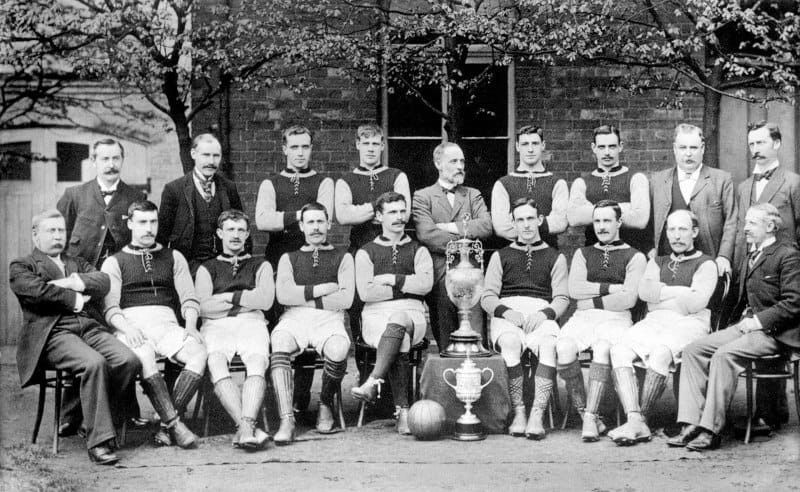
The Aston Villa team in 1897, after winning both the FA Cup and the English Football League
How the Sport Expanded Around the Globe
At the end of the 19th, and at the beginning of the 20th centuries, soccer had expanded beyond Britain. British sailors, merchants, and expats soon introduced the sport to other countries that they visited. In South America, soccer really took off in countries such as Brazil, Argentina, and Uruguay. In areas such as Africa and Asia, it was the colonial influence that helped the sport to establish, with clubs and leagues formed in many regions.
In countries like India and Egypt, it was British troops and officials who organised matches. It didn’t take long for these matches to grab the attention of locals, who soon joined in. Countries like Ethiopia and Ghana saw soccer being embedded in community identity, with clubs doubling as social and political organisations during colonial resistance movements.
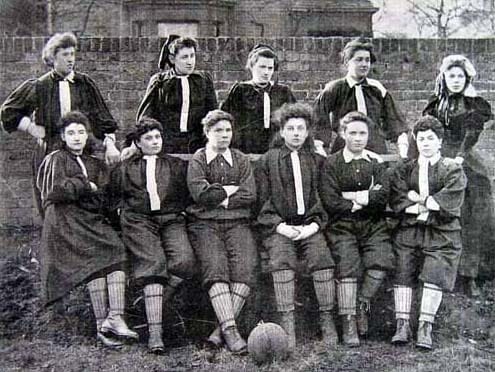
North team of the British Ladies’, the first organised women’s football team, here pictured in March 1895
The year 1904 saw the establishment of the Federal Internationale de Football Association (FIFA). Founded in Paris, its role was to oversee international competition. The emergence of FIFA was the start of soccer becoming a structured international sport. By 1930, the first World Cup was being held in Uruguay and this cemented the sports position as a global phenomenon. Uruguay came out on top, with 13 other teams having taken part, and this marked a new era in global sporting events.
Over the years, the tournament continued to expand, with more countries coming on board.This reflected the fact that the sport was becoming increasingly popular around the world. By the 21st century, the World Cup featured 32 teams and was watched by billions of fans around the world.

The FIFA World Cup is the largest international competition in football and the world’s most viewed sporting event. Photo via Антон Зайцев.
The Role of Clubs and Professional Leagues
As soccer continued to increase in popularity, clubs and leagues formed as the game became more professionalised. In England, the football league was established in 1888, becoming the first organised league competition in the world. It wasn’t long until this model spread across Europe, and the rest of the world. Soon, there were national leagues in countries the world over.
In South America, there were club giants such as Flamengo in Brazil and River Plate in Argentina. In Asia, it was clubs like Al-Hilal in Saudi Arabia and Urawa Red Diamonds in Japan that became the powerhouses across the continent. Over in Africa, leagues in Egypt, Tunisia, and South Africa helped to nurture generations of elite players.
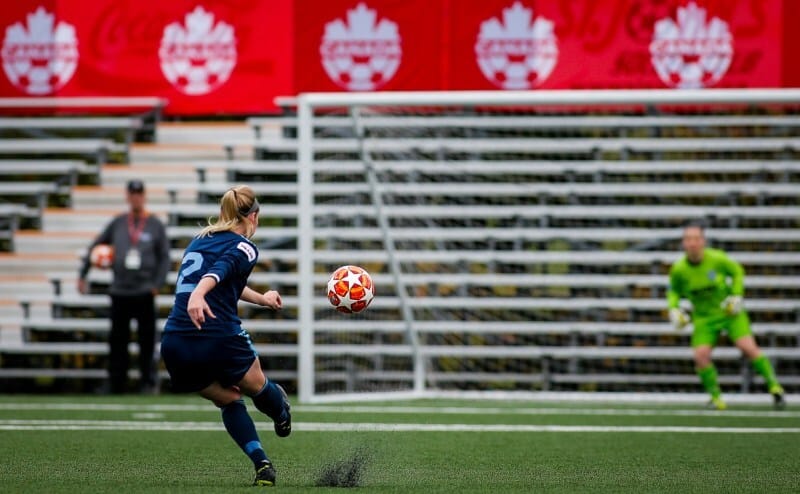
It took a while longer, but North America also saw its soccer scene develop. Major League Soccer (MLS) was launched in 1996 and initially it saw slow growth and skepticism. However, the league has now grown and has attracted international talent, while also fostering domestic development.
The arrival of club soccer allowed for consistent training, talent development, and fan engagement. It didn’t take long for teams such as Manchester United, Real Madrid, and Boca Juniors to develop massive followings, and this has led to them now having rich histories. Club competitions like the UEFA Champions League have also helped to boost, and maintain, the interest in club soccer.
The financial side of soccer has also expanded over the years, with the introduction of sponsorship and commercial partnerships. It has become commonplace for those linked to digital entertainment and betting industries to be involved. As an example, the likes of Stake.com have become an established part of the scene and are now synonymous with soccer.

Rules and Innovations Over Time
When you look at the core rules that were introduced in 1863, many of these have remained intact. However, there has also been a host of changes and refinements to the sport over the years. There was the introduction of the yellow and red card in the 1970 World Cup, showing how players could be disciplined. Then, in 1992, the back-pass rule was introduced. The stopped goalkeepers from picking up the ball when teammates had deliberately passed to them, and this led to a fast flowing game.
Some of the most recent innovations include the likes of goal line technology and Video Assistant Referee (VAR). These systems are both about improving the accuracy of the decisions made by officials. They reflect the way that the sport is making efforts to be fair.
On-pitch tactics and formations have also changed, with managers and coaches having the ability to completely transform their teams. There is now also a real focus on nutrition and sports science in attempts to make the sport more professional than ever.
The modern game also has advanced statistical analysis so that teams can monitor player workload in real-time. This helps them to make strategic decisions. The level of statistics on offer is also playing a major role for those looking to place a soccer bet, with the insights available being more in-depth than ever before.

Photo via vietnam beautiful on Unsplash.
The Cultural Impact of Soccer
The influence that soccer has goes way beyond what happens on the pitch. The sport has now become a major part of national identity and pride in many countries around the world. When you look at major tournaments, such as the World Cup, these generate passionate support with billions of die-hard fans tuning in to catch the action. These fans come from all over the world.
The sport has also played an important role in social change. The likes of Pele, Diego Maradona, Lionel Messi, and Cristiano Ronaldo have become true cultural icons. This has allowed soccer to bring attention to issues such as racism, gender equality, and political injustice.
Women’s soccer has also enjoyed major growth in recent times. The very first FIFA Women’s World Cup took place in 1991 and, since then, each tournament has got bigger and better, being recognised as a truly legitimate competition. Countries such as England, the US, Germany, and Japan, have string development programs that are all about growing the women’s game.
It’s easy to see the cultural reach of the sport in art, film, music, and literature. Documentaries and biopics celebrate legends in the sport while street art is used to pay homage to some of the most iconic moments in the sport.

Final Thoughts
When trying to establish who invented soccer, this goes beyond just identifying a single individual, or even culture. The reality is that this sport has evolved over millennia and has been inspired by various ball games that were enjoyed across the ancient world. The codification of rules in England during the 19th century gave rise to the modern game that we recognise today, but the true origins of the game are shared by many cultures.
No matter where it first came from, there’s no denying that soccer is now the most popular sport in the world. No one in the early days could have ever foreseen how this would be transformed into a true global phenomenon.
The post Who Invented Soccer? Exploring the Early Days of the Sport appeared first on Moss and Fog.
